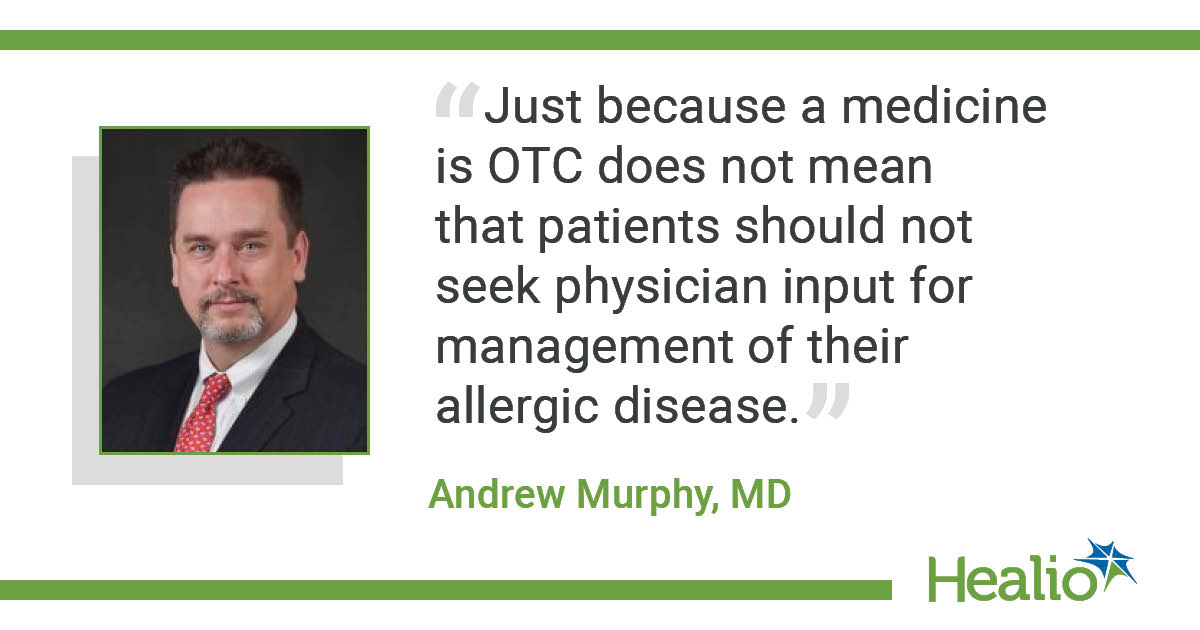Clinicians welcome FDA’s approval of Pataday OTC
Several physicians who spoke with Healio Primary Care applauded the FDA’s decision to make Pataday Twice Daily Relief and Pataday Once Daily Relief available over the counter to patients 2 years of age and older with itchy eyes associated with allergic conjunctivitis.
However, one expert expressed concern that the FDA’s decision is part of a larger trend that may put allergy medication out of the reach of some patients and may even put their health at risk.
Previously, Pataday Twice Daily Relief (olopatadine HCl ophthalmic solution/drops 0.1%, Alcon) and Pataday Once Daily Relief (olopatadine HCl ophthalmic solution/drops 0.2%, Alcon) were only available by prescription.

‘A good thing’
J. Allen Meadows, MD, president of the American College of Allergy, Asthma and Immunology and an allergist at Alabama Allergy and Asthma Clinic, explained that “anytime you can give patients something that will provide temporary relief from allergy symptoms like itchy and red eyes due to pollen, ragweed, grass, animal hair or dander linked to allergy conjunctivitis is a good thing.”

He added that other OTC eye drops for allergic conjunctivitis do not provide complete allergy symptom relief, making Pataday a reasonable treatment option for physicians to consider.
“There’s nothing similar to Pataday that’s available OTC. The vast majority of OTC eye drops for allergic conjunctivitis symptoms only eliminate the red eyes, not the itchiness,” Meadows said. “To be very honest, Pataday is safer than most other medications out there. I would prefer my patients use it.”
Michael S. Cooper, OD, an optometrist with Solinsky EyeCare, LLC Associates in West Hartford, Connecticut, also recommended Pataday.

“There really is no comparable over-the-counter eye drop therapy available,” he told Healio Primary Care. “The olopatadine molecule has been a tremendous benefit to my patients for more than a decade.”
Cooper said the FDA’s decision could increase access to Pataday among the approximately 15% to 25% of Americans who suffer from seasonal allergic conjunctivitis and perennial allergic conjunctivitis.
“This decision will allow for easy access to the medication and perhaps bring it to the attention of patients who had never heard of it before now,” he said.
Potential downsides
Andrew Murphy MD, a board-certified allergist with Suburban Allergy Consultants in Pennsylvania, told Healio Primary Care that although he is not opposed to the FDA’s decision regarding Pataday, some patients may not be able to afford it.
“Once a medicine is moved to OTC status, that medicine is no longer covered by insurance,” he explained. “This shifts the full cost of the medicine solely to the patient who is already paying for insurance coverage. I am not aware of any insurer who reduces the cost of their premiums when a patient’s meds receive OTC status.”
Meadows said he expected the retail price of Pataday to be between $20 and $30, which is also about what it cost when it was only available by prescription.
“I hope it won’t be more than that,” he said. “However, my experience with allergy drugs is that is that they are initially more expensive than their prescription price, but then the price goes down about 6 months later. This is what happened with Flonase.”
Tonya Winders, MBA, president and CEO of Allergy & Asthma Network, shared Murphy’s concerns about Pataday’s cost.
“Ironically, patients often lose access to medications when they go OTC as many insurers and payers use this as a loophole to not cover the cost. Pataday is currently around $50 to $60 for cash pay patients. I foresee patients being unable to afford it unless priced differently,” she told Healio Primary Care.
An Alcon representative told Healio Primary Care that the manufacturer’s suggested retail price for Pataday Once Daily Relief will be $21.99 and $18.49 for Pataday Twice Daily Relief. The representative continued that the product is “anticipated to sell at an accessible price that is typically less than the average prescription out-of-pocket cost.”
Even with that information, Winders said she was still concerned about Pataday’s affordability.
“The reality is, even with a price between $20 and $30, many patients will not afford it due to out of pocket,” she said. “For many Pataday users, the copay for the drug was anywhere from $0 to $20 copay before the drug went OTC.”
Murphy expressed concern that the FDA’s Rx-to-OTC switch process fails to consider the disease that the medicine is intended to treat.
For example, he recalled how two patients asked him for a prescription for steroids because their hives were not responding to an OTC antihistamine, which had previously only been available by prescription, he said.
“The patients actually had shingles — one with shingles in the face that was potentially vision threatening and the other with shingles on the torso,” Murphy continued. “Without my insisting to see these patients, they could have had catastrophic medical complications from improperly using a ‘safe’ OTC antihistamine for the incorrect self-diagnosis. Just because a medicine is OTC does not mean that patients should not seek physician input for management of their allergic disease.”
Winders added that although Pataday is “overall” a safe medication, there have been instances of blurred vision and headaches tied to its use.

“Luckily, these side effects are uncommon,” she said. “But physician oversight and monitoring are important for all medications, and this often is lost when medications become over the counter.”
Alcon said in a press release that both formulations of Pataday will be available to consumers on March 2. – by Janel Miller
Reference: Ackerman S, et al. Ther Adv Chronic Dis. 2016;doi:10.1177/2040622315612745.
Disclosures: Cooper reports grant and research support from Bausch + Lomb, Novabay Pharmaceuticals, Sight Sciences and Takeda/Shire; and advisory, consultant or speaker fees from Alcon, Allergan, Bausch + Lomb, Bio-Tissue, Epocrates, Eyevance Pharmaceuticals, Glaukos, inVentiv Health, Johnson & Johnson Vision Care, Novabay Pharmaceuticals, Sun Ophthalmics, Takeda/Shire, TearScience and The Mentholatum Company. Meadows, Murphy and Winders report no relevant financial disclosures.
